 Casey Research Station (WAP AUS-Ø2):
Casey Research Station (WAP AUS-Ø2):
Snow, ice and below-zero temperatures haven’t dissuaded Australia’s Antarctic expeditioners from paying their respects on Anzac Day.
The team of 26 held a dawn service at Casey Research Station (WAP AUS-Ø2) on Wednesday morning. It was led by expeditioner Rebecca Jeffcoat, who has been with the Royal Australian Navy for 28 years and served in the Middle East.
“I’ve been to many Anzac Day events over the years and today’s service, held against a backdrop of icebergs in Newcomb Bay, is one I will never forget,” she said.
The team, who are spending the winter at the research station, gathered under the flag-pole in -15°C.
“Expeditioners took the opportunity to proudly share their family member’s service experience; in the Boer War, lost at sea in World War II and in Afghanistan,” Ms Jeffcoat said.
Source: http://www.antarctica.gov.au/news/2018/anzac-day-in-antarctica
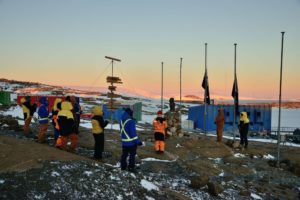
Mawson Research Station (WAP AUS-Ø4):
Anzac Day represents a significant day in the calendar of events down south. With calm winds and a pink sky at Mawson we held a Dawn Service on ANZAC Day to remember those men and women from Australia and New Zealand who died or suffered in the tragedy of war.
Pic aside: The ANZAC Day Dawn Service at Mawson. (Photo: Pete Layt)
Australia’s Antarctic program has long links with the Australian Defence Force since it was founded in 1947.
TNX and credit to: http://www.antarctica.gov.au/
Too bad, no Ham radio operation has been performed to mark Anzac day! Hope to hear some VKØs active on HF from there soon.

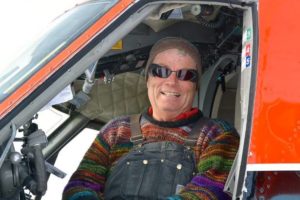 Starting his career as a Certified Swiss Mountain Guide, Henry Perk acquired his commercial pilots license and Ham license while guiding in the Canadian Rockies.
Starting his career as a Certified Swiss Mountain Guide, Henry Perk acquired his commercial pilots license and Ham license while guiding in the Canadian Rockies.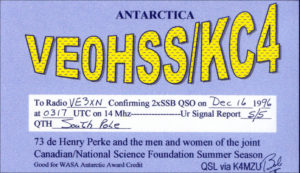 While in Antarctic each summer in the 1990’s Henry operated from many large and small locations as Siple Dome Station (WAP USA-18), Vostok Station (WAP RUS-13), WASA (WAP SVE-Ø4), ABOA (WAP FIN-Ø1), South Pole Station (WAP USA-21), McMurdo (WAP USA-22), Dome Charlie (WAP USA-Ø5), and many others.
While in Antarctic each summer in the 1990’s Henry operated from many large and small locations as Siple Dome Station (WAP USA-18), Vostok Station (WAP RUS-13), WASA (WAP SVE-Ø4), ABOA (WAP FIN-Ø1), South Pole Station (WAP USA-21), McMurdo (WAP USA-22), Dome Charlie (WAP USA-Ø5), and many others.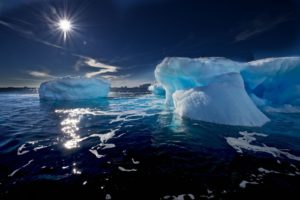 The iceberg graveyard in Petermann Bay in Antarctica provides plenty of opportunity for whales, seals, penguins and other seabirds to feed along. Wind and current have created an iceberg graveyard here. The ice groans and sighs. The icebergs crackle and sparkle, buck and roll in the brilliant sunlight, reflecting every shade of blue.
The iceberg graveyard in Petermann Bay in Antarctica provides plenty of opportunity for whales, seals, penguins and other seabirds to feed along. Wind and current have created an iceberg graveyard here. The ice groans and sighs. The icebergs crackle and sparkle, buck and roll in the brilliant sunlight, reflecting every shade of blue. On one of the thirteen Argentine Research Stations in Antarctica, Esperanza Base (WAP ARG-Ø4), we find the Chapel of San Francisco de Asís. The Esperanza base is inhabited all year round by civilians and is considered by the Argentines, as the southernmost city of the country, although it is only a small village. Besides the church, the base also has a school, a museum, a bar, a casino and a hospital with permanent maternity service and where enough Argentines have come to the world.
On one of the thirteen Argentine Research Stations in Antarctica, Esperanza Base (WAP ARG-Ø4), we find the Chapel of San Francisco de Asís. The Esperanza base is inhabited all year round by civilians and is considered by the Argentines, as the southernmost city of the country, although it is only a small village. Besides the church, the base also has a school, a museum, a bar, a casino and a hospital with permanent maternity service and where enough Argentines have come to the world.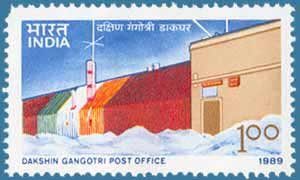 The Post Office was part of the Research Base known as Dakshin Gangotri (WAP IND-Ø1). It was set up during the third Indian expedition to the Antarctic but after six years of rigorous service, the place was decommissioned. The whole place got buried under the heavy blanket snow and is now marked as a historical site. The Post Office became operational on February 24, 1984 and was part of multiple support systems at Dakshin Gangotri. The other facilities included an ice-melting plant, accommodation, recreation facilities, laboratories, storage, a clinic and a bank counter. The Dakshin Gangotri Post Office was established under the Department of Post Office at Goa on January 26, 1988. Scientist G. Sudhakar Rao was appointed as the first Honorary Postmaster. He had gone to the Antarctic as a member of the Seventh Indian Scientific Expedition in 1987. In the very first year of its foundation, almost 10,000 letters were posted and cancelled in the Dakshin Gangotri post office..
The Post Office was part of the Research Base known as Dakshin Gangotri (WAP IND-Ø1). It was set up during the third Indian expedition to the Antarctic but after six years of rigorous service, the place was decommissioned. The whole place got buried under the heavy blanket snow and is now marked as a historical site. The Post Office became operational on February 24, 1984 and was part of multiple support systems at Dakshin Gangotri. The other facilities included an ice-melting plant, accommodation, recreation facilities, laboratories, storage, a clinic and a bank counter. The Dakshin Gangotri Post Office was established under the Department of Post Office at Goa on January 26, 1988. Scientist G. Sudhakar Rao was appointed as the first Honorary Postmaster. He had gone to the Antarctic as a member of the Seventh Indian Scientific Expedition in 1987. In the very first year of its foundation, almost 10,000 letters were posted and cancelled in the Dakshin Gangotri post office..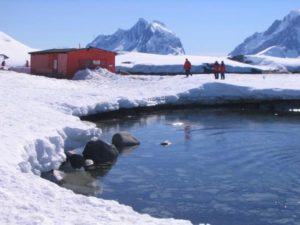 Opened on February 6, 1955, Grussac Naval refuge (65° 10’ 33” South, 64° 08’ 10” West), on Petermann Island, was originally named to Hipólito Bouchard. , It takes its current name in homage to Paul Groussac (1848-1929), a French writer and historian based in Argentina and author of an allegation about the Argentine sovereignty of the Falkland Islands. Close to this Argentine naval refuge ( an old corrugated iron shack in rusted colors), lays a simple cross monument, an unreadable metal plaque with just one word “John” recalls the dead of a man of the British Antarctic Survey, who tried to get here over the sea ice in 1982..
Opened on February 6, 1955, Grussac Naval refuge (65° 10’ 33” South, 64° 08’ 10” West), on Petermann Island, was originally named to Hipólito Bouchard. , It takes its current name in homage to Paul Groussac (1848-1929), a French writer and historian based in Argentina and author of an allegation about the Argentine sovereignty of the Falkland Islands. Close to this Argentine naval refuge ( an old corrugated iron shack in rusted colors), lays a simple cross monument, an unreadable metal plaque with just one word “John” recalls the dead of a man of the British Antarctic Survey, who tried to get here over the sea ice in 1982..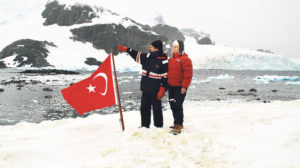 Faruk Ozlu said on Wednesday.
Faruk Ozlu said on Wednesday.
 A scientific expedition will next year try to find the Endurance, the ill-fated ship of Antarctic explorer Sir Ernest Shackleton. The vessel sank in 1915, crushed by sea-ice in the Weddell Sea and lost in 3,000m of water.
A scientific expedition will next year try to find the Endurance, the ill-fated ship of Antarctic explorer Sir Ernest Shackleton. The vessel sank in 1915, crushed by sea-ice in the Weddell Sea and lost in 3,000m of water. Scientists in Antarctica have harvested their first crop of vegetables grown without earth, daylight or pesticides as part of a project designed to help astronauts cultivate fresh food on other planets.
Scientists in Antarctica have harvested their first crop of vegetables grown without earth, daylight or pesticides as part of a project designed to help astronauts cultivate fresh food on other planets. Indian Antarctic Program did start in 1981 with the first Indian expedition to Antarctica, a huge geo-political achievement. Dr. S Z Qasim, Secretary of Department of Environment and former Director of NIO was selected as the leader of the 21 member Team.
Indian Antarctic Program did start in 1981 with the first Indian expedition to Antarctica, a huge geo-political achievement. Dr. S Z Qasim, Secretary of Department of Environment and former Director of NIO was selected as the leader of the 21 member Team.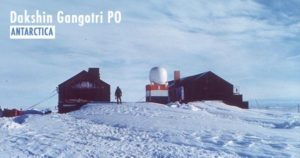 carry out scientific work Dakshin Gangotri was built in eight weeks by an 81 member Team. With help from the Indian army they did complete the construction in January 1984.
carry out scientific work Dakshin Gangotri was built in eight weeks by an 81 member Team. With help from the Indian army they did complete the construction in January 1984.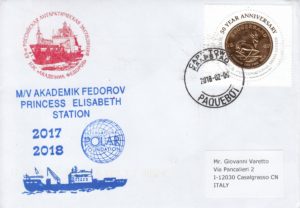 Great job is done by several worldwide Polar Philatelist Societies, just available on the web to learn and share the common interest in stamps, covers, and postal history. An interesting site with lots of links and information can be found here:
Great job is done by several worldwide Polar Philatelist Societies, just available on the web to learn and share the common interest in stamps, covers, and postal history. An interesting site with lots of links and information can be found here:  Happy Easter from WAP Staff
Happy Easter from WAP Staff